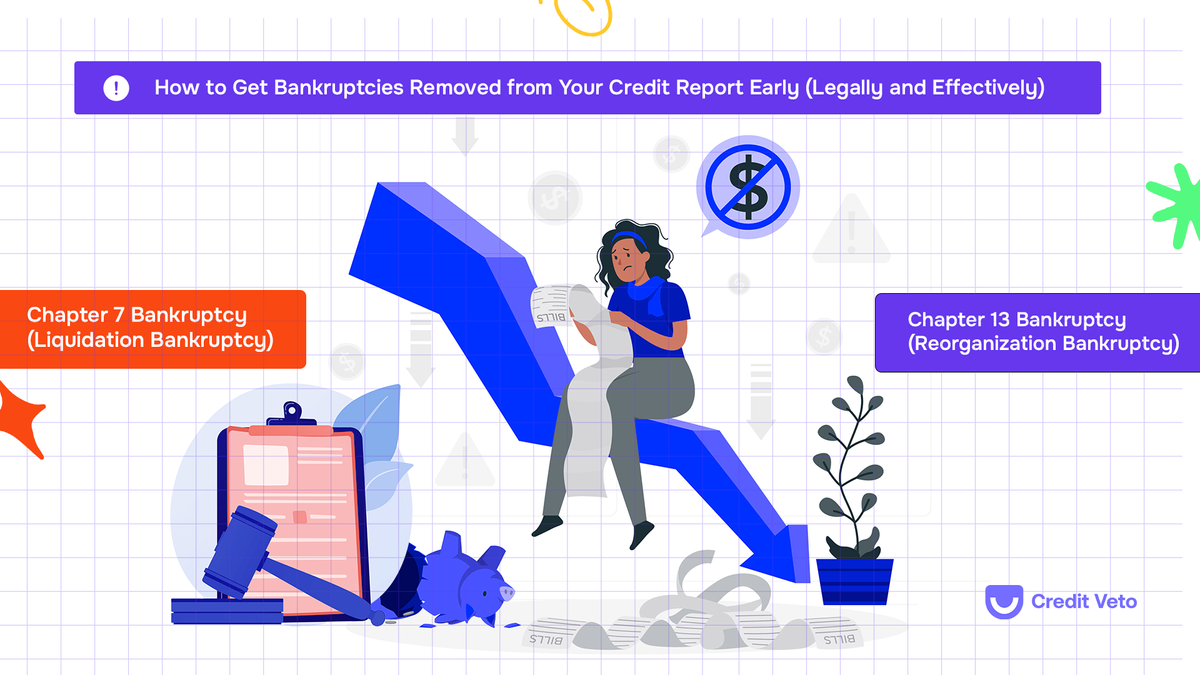How to Remove Bankruptcy from Your Credit Report Early
Want to get a bankruptcy off your credit report before 10 years? Discover legal ways to dispute dismissed or discharged bankruptcies and boost your credit score.

If you’ve filed for bankruptcy, you’re not alone — but that doesn’t mean your credit has to suffer for the next decade. Many people believe that bankruptcy must stay on your credit report for 7 to 10 years no matter what.
The truth? There are legal ways to get bankruptcies removed from your credit report early, especially if the information is inaccurate or cannot be verified.
This guide breaks down everything you need to know about:
- How long bankruptcies stay on credit reports
- How to remove dismissed or discharged bankruptcies
- How to write dispute letters for bankruptcy removal
- Ways to rebuild credit even if bankruptcy still appears
And lots more. So grab a quick coffee and continue reading to learn everything you need to know.
What Is Bankruptcy and How Does It Affect Your Credit?
Bankruptcy is a legal process that helps individuals or businesses eliminate or repay debts under the supervision of a court. It provides relief for those who can no longer manage their financial obligations, but it also comes with serious consequences.
One of the most significant impacts of bankruptcy is how it affects your credit report and credit score. Lenders use this information to assess how risky you are as a borrower. Since bankruptcy signals that you were unable to repay previous debts, it makes it much harder to get approved for credit, loans, or even housing in the future.
Types of Bankruptcy and Their Impact on Credit Reports
There are different types of bankruptcy filings, but the most common for individuals are Chapter 7 and Chapter 13. Each type has its own rules and consequences, including how long it stays on your credit report.
Chapter 7 Bankruptcy (Liquidation Bankruptcy)
- Stays on your credit report for 10 years from the filing date.
- This type of bankruptcy involves selling off non-exempt assets to pay creditors.
- Typically used by those who have little to no disposable income and cannot afford a repayment plan.
Chapter 13 Bankruptcy (Reorganization Bankruptcy)
- Stays on your credit report for 7 years from the filing date.
- Allows debtors to restructure their debts and repay them over a period of 3-5 years.
- Usually filed by individuals who have a stable income and want to keep their assets, such as a home or car.
How Bankruptcy Affects Your Credit Score
Your credit score takes a major hit when you file for bankruptcy. The severity of the drop depends on your credit score before filing.
- If you had a good credit score (700 or higher) before filing, you could see a drop of 150-200 points or more.
- If your score was already low due to missed payments and high debt, the impact may not be as drastic.
- A bankruptcy on your credit report makes it harder to qualify for credit, get approved for loans, or rent an apartment. However, its impact lessens over time, especially if you take proactive steps to rebuild your credit.
How Long Does Bankruptcy Stay on a Credit Report?
Bankruptcy isn’t permanent, but it does stick around for a while if left unchallenged.
How Long Does Bankruptcy Stay on Your Credit Report?
Here’s a quick breakdown:
That means even if you’ve paid off all the debts included in your bankruptcy, the public record entry can still linger for years and significantly lower your credit score.
Many people don’t realize that even dismissed bankruptcies (cases that were not completed) can show on their credit reports — and those can often be disputed and removed faster.
Can You Remove Bankruptcy from Your Credit Report Early?
Yes, if the information is inaccurate, outdated, or unverifiable, you have the legal right to dispute it and request removal. The Fair Credit Reporting Act (FCRA) protects your right to have only accurate, verified information on your credit report.
That means:
- If the bankruptcy listing has errors
- If the reporting agency can’t verify the record
- Or if the court says they don’t report bankruptcies to credit bureaus
...then you may have a valid case to remove bankruptcy from your credit report early.
How to Get Bankruptcies Removed from Credit Report Early: Step-by-Step Guide
This process works for both dismissed and discharged bankruptcies. Here’s how to do it:
1. Get Your Credit Reports
Start by pulling your reports from all three credit bureaus (Equifax, Experian, and TransUnion) at AnnualCreditReport.com.
2. Look for Errors or Inconsistencies
- Common issues include:
- Wrong court name or location
- Incorrect filing date
- Bankruptcy marked as dismissed when it wasn’t — or vice versa
- Duplicate entries
- Missing or incomplete docket numbers
These issues matter. They give you a reason to dispute.
3. Write a Letter to Remove Dismissed Bankruptcy from Your Credit Report
If your case was dismissed, you have a strong chance of removing it early. Write a dispute letter to the credit bureaus requesting them to remove the dismissed case because it was not a completed bankruptcy.
Sample reasons to use in your letter to to removing dismissed bankruptcies from credit report
"This case was dismissed and should not be listed as a public record."
"This entry is inaccurate and harmful to my credit profile."
4. Contact the Bankruptcy Court
Send a polite inquiry to the court that handled your case and ask, “Do you report bankruptcy cases directly to credit bureaus?” Most courts will confirm that they do not report to them directly.
5. Send the Court’s Response to the Credit Bureaus
Once you have confirmation, send it to the bureaus along with your dispute. If the bureau can’t verify the bankruptcy independently, they’re required by law to delete it.
6. Dispute Any Related Discharged Debt
Sometimes, even after a bankruptcy discharge, old debts still show up as active or unpaid. You can dispute these as well.
Now here's how to remove discharged debt from my credit report. Make it clear that the debt has been discharged and should show a zero balance or be removed altogether.
Common Errors in Bankruptcy Listings (Look for These)
Many consumers don’t realize that errors in public records are common. These mistakes could be your leverage in a dispute.
Here are common issues to look for:
- Incorrect court name or location
- Wrong filing date
- Incomplete or missing docket number
- Listing not marked as “Discharged” or “Dismissed”
- Duplicate entries from multiple bureaus
- Public record listed under the wrong name (identity mix-up)
Any of these errors may give you grounds for an early removal.
How to Remove Discharged Debt from My Credit Report
After bankruptcy, all discharged debts should be
- Marked as included in bankruptcy
- Showing a $0 balance
- Reporting as closed accounts
If any account still appears open or unpaid, file a dispute with each credit bureau. Include your bankruptcy discharge paperwork as proof. These errors can hurt your score and mislead lenders, even though the debt is no longer owed.
Tools That Help Automate the Process
If you’re managing multiple clients or don’t want to handle everything manually, platforms like Credit Veto help automate:
- Credit report analysis
- Dispute letter generation
- Tracking updates and responses from bureaus
- Automating dispute rounds with follow-ups
This saves time and increases the chances of getting inaccurate records removed.
What Happens After Bankruptcy Is Removed?
Successfully removing a bankruptcy from your credit report — especially before the 7- or 10-year timeline — can have a powerful impact on your financial future. Here’s what typically happens next, and how to make the most of it:
1. You’ll Likely See an Increase in Your Credit Score
The exact increase in your score depends on the rest of your credit profile, but many people see jumps ranging from 50 to 150 points after a bankruptcy is deleted. This is because public records like bankruptcy carry a heavy weight in credit scoring models.
The removal clears a major red flag from your credit history, which can instantly make you appear more creditworthy to lenders and boost your overall score — especially if you've already started rebuilding positive credit.
> Pro Tip: If you also have discharged accounts or collections that were tied to the bankruptcy, dispute and remove those as well. The cleaner your report, the stronger your score recovery.
2. Lenders May View You as Less Risky
With the bankruptcy removed, lenders will no longer see you as someone who previously couldn’t repay debt. This can lead to:
- Easier approvals for credit cards, car loans, or even mortgages
- Access to lower interest rates
- Higher credit limits
- More favorable loan terms overall
Without a bankruptcy weighing down your credit profile, you’ll be more competitive in the eyes of banks, credit unions, and even rental applications or employers that run credit checks.
3. You Can Start Applying for Credit with Better Terms
Once the bankruptcy is off your report, you can begin applying for credit with confidence and leverage. While you should still be cautious about how much credit you take on, you’ll likely:
- Qualify for unsecured credit cards with rewards
- Be offered auto loans with reasonable interest rates
- Potentially get pre-approved for home loans or refinancing
Just remember: Don't rush to open multiple accounts at once. Instead, choose one or two well-structured credit products that will help you continue building credit the right way.
4. It’s Important to Continue Building Positive Credit Habits
Removing the bankruptcy is a huge win — but it’s not the end of your credit journey. To maintain and grow your score long-term, focus on consistent, responsible credit behavior.
Here’s how:
- Make every payment on time — even one late payment can set you back.
- Keep credit utilization low — aim to use less than 30% of your available credit.
- Monitor your credit regularly — watch for errors or changes and address them immediately.
- Avoid applying for too much credit at once — each hard inquiry can impact your score.
- Maintain a mix of credit types — responsibly managing both revolving and installment credit helps build a strong profile.
Removing bankruptcy is like getting a fresh start. But just like in business or life, what you do after the reset matters just as much as how you got there.
How to Rebuild Your Credit After Bankruptcy
Even if removal isn’t successful right away, don’t wait to rebuild your credit. Whether you’re disputing your bankruptcy or waiting for it to fall off naturally, these steps help you bounce back faster:
1. Get a Secured Credit Card

Use it for small purchases and pay it off each month. This shows responsible usage.
2. Pay All Bills On Time
Even one late payment can drop your score significantly. Set reminders or automate payments.
3. Keep Your Credit Utilization Low
Try to use no more than 30% of your available credit. Under 10% is even better.
4. Become an Authorized User
Ask a family member with good credit to add you to their card. As an authorized user, their positive history helps your score.
5. Use Credit-Building Tools
Credit builder loans, rent reporting, and DIY tools from Credit Veto can help increase your score faster.
FAQs: Real People’s Questions Answered
Q: Does bankruptcy automatically come off your credit report?
A: Yes. A Chapter 7 comes off after 10 years, and Chapter 13 falls off after 7 years. But you can attempt early removal through dispute.
Q: Can I remove a dismissed bankruptcy from my credit report?
A: Yes. Since a dismissed bankruptcy means it was not completed, you can send a dispute letter to request removal. Credit bureaus often remove dismissed cases if they can't verify them.
Q: How to remove discharged debt from my credit report?
A: You can dispute any account that was included in bankruptcy but still shows a balance. Provide your discharge paperwork, and the bureau is required to update or delete it.
Q: Can you remove bankruptcy from credit report early?
A: Yes, especially if the listing is inaccurate or unverifiable. Courts don’t report to credit bureaus directly, which gives you legal grounds to dispute.
Q: What letter should I send to get bankruptcy removed?
A: A personalized dispute letter referencing the inaccuracies in the listing or the dismissal status of the case. You should also request verification and attach any documentation available.
Final Thoughts
You don't have to live with a bankruptcy on your credit report for 10 years. By understanding your rights and using the right strategy, you can get bankruptcies removed from your credit report early or at least correct the damage they leave behind.
Whether you’re fixing your own credit or helping others as a credit repair business owner, mastering this process gives you a major advantage.
Need help drafting letters, automating disputes, or building or improving your credit? Credit Veto helps you do it all — faster, easier, and legally. Sign up for our exclusive packages to get started and say hello to your brighter financial future.




Comments ()